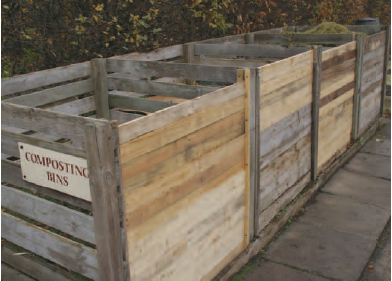Composting
ContentCompost is a dark, soil-like material made of decomposed organic matter. Many gardeners depend on composting as a means of using garden refuse to maintain organic matter levels in their soils. On a larger scale there is interest in the use of composted town refuse for horticultural purposes. Many councils are now collecting ‘green waste’ and supplying composting equipment to encourage householders to recycle organic matter, as well as paper, glass and metals. Horticulturists are increasingly concerned with the recycling of wastes and attention is being given to modern composting methods. It is fundamental to successful organic growing. For successful composting, conditions must be favourable for the decomposers. The material must be moist and well aerated throughout. As the heap is built, separate layers of lime and nitrogen are added as necessary to ensure the correct pH and C:N ratio. Organic waste brought together in large enough quantities under ideal conditions and turned regularly can be composted in two to three months. It is an exothermic process (heat is given off in the reactions) so enough heat can be generated to take the temperature to over 70°C within seven days, with the advantage of killing harmful organisms and weed seeds. The high temperatures can lead to a loss of ammonia (nitrogen).
When very large quantities are available the ingredients can be heaped up on a concreted base. This makes it easy to use power equipment to turn the ingredients to maintain good aeration and to mix in the cooler outer layers to ensure all parts heat up and decompose rapidly. Garden methods Most gardeners will not be able to obtain enough components at any one time to create the ideal composting process. An alternative approach is to build the heap over time. This is normally done in a slatted bin with a front that opens for access (see Figure 18.7). There should be an open base over soil to allow organisms and air in. A suitable cover is needed to keep some warmth in and rain off once the process has started. This method can produce good compost, but tends to take many months or even years to complete. Because it does not heat up adequately, care should be taken with regard to weeds, pests and diseases which are not killed in the process.
As much material as possible should be collected and prepared for composting. It should be chopped or shredded, ‘green’ and ‘brown’ mixed and water added to the heap. It is difficult to be successful with batches of less than one cubic metre at a time (when less than this the cooling at the surface is greater than the heating at the centre where decomposition is proceeding). It is advantageous to have a second bin alongside so the compost heap can be turned and loosened more easily on a regular basis to maintain good aeration. Compost tumblers These are containers that can be rotated on an axis to provide an easy method of turning small batches to create compost in a relatively short time. Batches can heat up sufficiently to kill off weeds and diseases and the enclosed container deters vermin. The compost ingredients should be gathered together and the tumbler filled in a short space of time. Nothing is added until the batch is completed. Worm composting and wormeries Worm composting lends itself to handling small quantities which can be added as they arise, such as kitchen waste, especially over the winter period when there is little plant material to accumulate. Compost worms (Eisenia foetida), also known as brandling or tiger worms, feed on organic matter. Whilst these can be purchased they are readily found in rotting vegetation such as compost heaps. The container can be a plastic dustbin, usually equipped with a tap to drain off liquids which can be diluted and used as liquid feed for plants. Smaller containers, wide rather than narrow, can be made out wood, ideally with some insulation to maintain temperatures. Put in a 10 cm layer of sand and cover with a polythene sheet. Bedding material, such as well rotted compost or farmyard manure, may be needed for the worms to live in until the system gets going. Spread chopped waste to a depth of 5 cm. Add 100 or so worms and cover with wet newspaper to keep out the light and maintain moisture levels. A lid is needed to keep out the rain. Ideally, temperatures should be maintained between 20°C and 25°C and the pH kept between 6 and 8; lime can be added if the compost becomes too acid. The worms eat the vegetation as it starts to rot which means that once in balance there is no smell. The compost is removed when ready; the decomposing top layer is separated off and used to start the next run. The compost is spread out to dry in the sun and the worms are recovered by placing a wet newspaper on the compost where they will congregate under it. On a larger scale, wormeries are used to compost farmyard manure with continuous systems available that separate the composted material from the worms which can be recycled, with surpluses being available as animal feed. |






